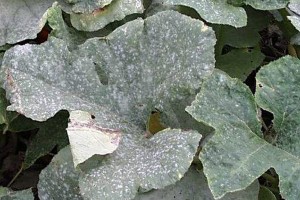The powdery mildew problem
Posted on June 23rd, 2009 by Phuong
Have you noticed white powdery appearance on leaves and other green parts of your plants?  It’s likely powdery mildew fungus, a common disease that can be found on squashes, roses, dahlias, cucumbers, pumpkins, azaleas, dogwoods and many more plants. The fungus often causes leaves to wilt, turn yellow, drop from the plant or curl up. The fungus thrives in moderate temperatures and high humidity, and tends to favor plants in shady, overcrowded areas.
It’s likely powdery mildew fungus, a common disease that can be found on squashes, roses, dahlias, cucumbers, pumpkins, azaleas, dogwoods and many more plants. The fungus often causes leaves to wilt, turn yellow, drop from the plant or curl up. The fungus thrives in moderate temperatures and high humidity, and tends to favor plants in shady, overcrowded areas.
On roses, you’ll find the powdery white growth on leaves, stems, buds or flowers. It typically appears on new growth during warm, dry days followed by cool, damp nights. The leaves may curl up, or look badly distorted. You may see tiny black spots amid the white talcum-powder dusting.
What can you do to prevent powdery mildew? Try to plant varieties that are resistant to the disease (for dogwoods, for example, C. kousa is a good choice). Plant roses, for example, in sunny spots, not shady areas that tend to take longer to dry out. Promote good airflow with selective pruning and proper spacing so plants don’t crowd and shade each other out, which encourages spore germination. Remove diseased parts of the plant and destroy all dead leaves (do not compost these clippings) since the fungi can survive the winter. Avoid overhead watering and getting the leaves wet especially late in the day when there’s no time for it to dry.
Cornell University has this good fact sheet on the disease. Researchers have discovered that baking soda combined with a horticultural oil can help fight powdery mildew on roses and other plants. Spray your plant about once a week with a solution of baking soda (1.5 tablespoon/gallon) and horticultural oil (3 tablespoons/gallon).
Filed under:Seattle Landscape Maintenance | Permalink |



